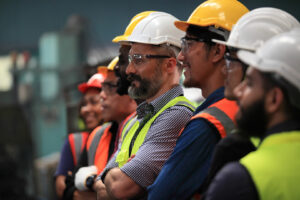
In the midst of some of the largest supply chain disruptions in modern memory, you can be forgiven for dealing with issues as they hit the desk (which could be a kitchen table in 2022 with hybrid models now suddenly the norm), the focus has been on surviving, not thriving – reacting rather than planning. For many supply chain professionals, the day-to-day pressures of business resilience and continuity have taken the fore, but the stresses of developing a sustainable business remain.
In contrast to the conflation that sustainable merely means “green”, the push for sustainability should encompass a multitude of other goals.
A sustainable business is an enterprise that has a minimal negative impact or potentially a positive effect on the global or local environment, community, society, or economy—a business that strives to meet the triple bottom line.
Sustainable business strategies are unique to each organisation as they tie into larger business goals and organizational values. For instance, sustainability in business can mean:
- Using sustainable (recycled, renewable) materials in the manufacturing process
- Optimizing supply chains to reduce greenhouse gas emissions
- Relying on renewable energy sources to power facilities
- Sponsoring education funds for youth in the local community
In this article, we discuss where the push for sustainable business practice comes from and what you can do to prepare for the ever-increasing demands for this in your business.
Under Pressure
There has been a significant rise over the past couple of years in the pressure being applied to the supply chain function in many organisations across sectors to adopt sustainable practices.
At a high-level, companies are being influenced by many different parties and sources.
These include but are not limited to:
- governmental bodies
- International governing bodies
- mass media
- local communities
- NGOs
- external corporate buyers
- employees
- company executives
- customers
- investors
This huge diversity of stakeholders makes navigating the internal and external drivers incredibly complicated. With the highest level of pressure hitting the c-suite through the conversations with investors and augmented by governments, and international governing bodies – sustainability is directly beginning to influence the commercial agenda.
Many supply chain executives are also pressured internally by the sales and marketing departments, as they view the business from a customer-centric lens and are striving for differentiation in crowded and profit-squeezed marketplaces.
Beyond the Supply Chain
Sustainability has to be adopted as a company-wide initiative, however, but often supply chain teams seem to bear the brunt of being the first port of call to hit targets and to implement operational changes to begin measuring sustainability.
There isn’t a magic bullet to becoming sustainable overnight, but considerations must be made for all key business functions:
- Design & Product Development
- Logistics
- Marketing
- Procurement
- Production & Manufacturing
- Sales
- Supply Chain
- Warehousing and Inventory
And each has a unique ability to affect performance metrics differently too – sales and marketing won’t necessarily have the environmental impact logistics will have.
Measuring Sustainability
Some of the metrics our clients have measured are as diverse as the stakeholders involved.
These include:
- Employee Welfare
- Employee safety
- Human rights
- Energy saving
- Renewable energy usage
- Local community impact
- Fair pay & fair trade
- Supplier diversity, equity and inclusion
- Climate change mitigation
- Water conservation
- End-of-life management and supply chain circularity
- Natural resource and biodiversity conservation
Tactics & Practices
Whereas we appreciate the magnitude and diversity of industries, functions and metrics available for measuring sustainability overall, the supply chain and procurement team focus and impact is incredibly important.
This poses the question… what can you in your role to embed sustainability into the supply chain?
Here is how SourceDogg is being used in 4 functional groups to achieve sustainable goals.
Supplier Development
- Company & Supplier Code of Conduct
- Supplier Training
- Supplier Audit
- Third-Party Verification
- Supplier Benchmarking
- Supplier Collaboration
Visibility
- Supply Chain Mapping
- Visibility & Traceability
Environmental Impact Reduction
- Carbon Offsets
- Environmental Technologies
Independent Practices
- Sustainability Standards & Certifications
- NGO or Third-Party Collaboration
- Information Technology
The Future Outlook
With so many external and internal pressures, functions, metrics and activities to complete, it’s not surprising that sustainability can feel like an overwhelming project to move forwards with – especially with the day-to-day disruptions to deal with.
The real problem is that the demand for sustainability in business isn’t going away. Investors demand it and we’ve seen in the US, that there was a record amount of capital invested into US Environmental, Social, and Governance (ESG) funds in 2020. Climate change and CO2 measures may define the next decade for many businesses as governments dedicate even more effort to this specific measure.
Social inequalities highlighted by the pandemic have brought this issue to be front of mind and even as we write this, unions are striking in some industries as inflation increases and the cost of living follows suit. With all of this in the mainstream media, the effect will start to affect consumer demands, tastes and trends.
Supercharging Sustainability with Data
Regardless of the department, goal or industry, the simple fact remains that sustainability is a journey from where you are to where you need to go.
Without data powering this – how do you know how sustainable your supply chain is? On what metrics and grounds? How can you successfully develop the supply chain to be more sustainable without data? How are you reaching out to your supply base to fill in the gaps? How are you working proactively with supplier relationship management to develop your supplier sustainability upstream?
We may be biased as a data-driven supply chain software platform, but SourceDogg is designed to help you effectively collect sustainability information, and analyse and evaluate your data.
This supplier master database then drives sustainability insight to subsequently make proactive decisions based on the data you have – facilitating the balance of commercial and sustainable interests.
We’d love to show you around the platform to help you and your teams supercharge your sustainability for massive commercial, environmental and social benefits.
Get in touch with one of our supply chain experts today…





